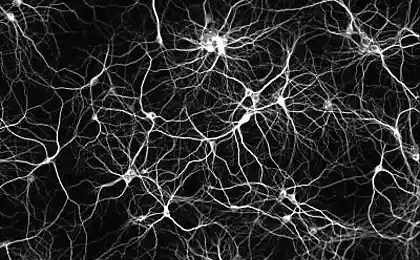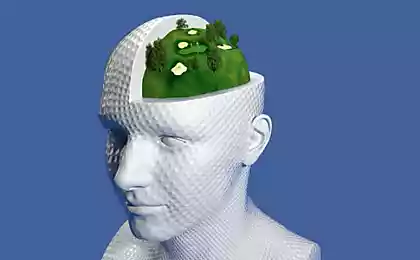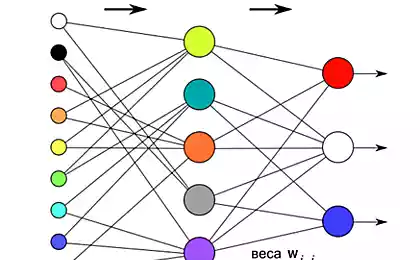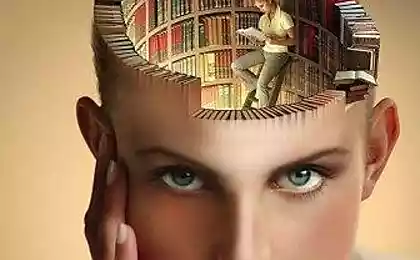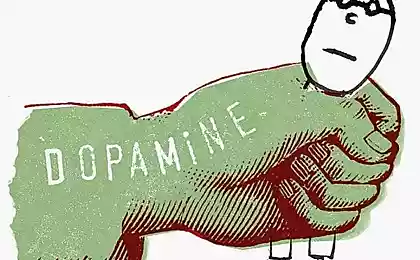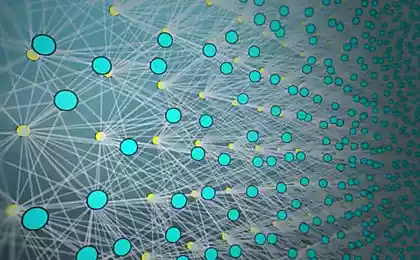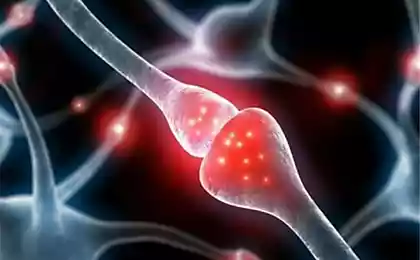547
To pump the brain: how the practice of mindfulness affects our neurons
Our brain is plastic — new neural connections can be formed and in adulthood. Moreover, with the help of special exercises to stimulate the development of these ties and to train certain areas and functions of the brain. American psychiatrist Daniel Siegel in his book "Mindsight: the new science of personal transformation," recently published in the publishing house "Mann, Ivanov and Ferber", talks about how to observe your own consciousness, allowing to make to their thinking changes on the neurobiological level.

© Akatre
When I first saw Jonathan, he just turned sixteen and he was in the tenth grade. He entered the room shuffling gait, his jeans hung low on hips, and long blond hair falling over his eyes. He said that the last couple of months it was bad and sad and occasionally for no reason at all he started to cry. I learned that his school was the company of close friends, and studying is no problem. He calmly, almost dismissively said that the house was fine: older sister and younger brother, he was sick and the parents are annoyed, as always. It seemed that nothing unusual in the life of Jonathan did not happen.
And yet something definitely went wrong. Tears and bad mood accompanied by Jonathan's uncontrollable fits of rage. Ordinary situation when, for example, the late sister or brother took his guitar without permission, he had the strongest anger. Just being with Jonathan, I felt his despair and moral exhaustion. He admitted that he had also realize that trouble sleeping, decreased appetite, and suicidal thoughts. But I have determined that while Jonathan has not made suicide attempts and had not planned them.
Sudden bursts of anger could talk about irritability as one of the main symptoms of depression, especially in children. But they equally well apply to the symptoms of bipolar disorder, often inherited and often manifested in adolescence.
At first, bipolar disorder is almost impossible to distinguish from so-called unipolar depression, in which mood just drops. However, in bipolar disorder the depression alternates with the lively, or activated, state of mania. Mania in adults and adolescents wasteful and irrational, they suffer from severe mood swings, you feel an exaggerated sense of self-importance and power, a decreased need for sleep, increased libido as food and sex. To distinguish unipolar from bipolar disorder need to find a suitable course of treatment, so I often consult about this diagnosis. In the case of Jonathan I caught two colleagues and they both agreed that bipolar disorder is highly likely.
From the point of view of the device of the brain in bipolar disorder characterized by strong dysregulation: a person is difficult to maintain emotional balance because of problems with coordination and stability of channels of the brain responsible for mood. As you already know, subcortical areas influence our feelings and mood, form motivation and behavior. The prefrontal cortex, located directly above the subcortical areas controlling our ability to balance emotions.
Regulating the channels of the brain may be denied for several reasons, some of them are genetic or constitutional, that is, unacquired aspects of temperament. According to one of the modern theories, in people with bipolar disorder observed the structural features of compounds regulating prefrontal channels located below the limbic lobes, responsible for the formation of emotions and moods.
"In addition to focus, there are other factors contributing to neuroplasticity: aerobic exercise and emotional excitement"
Sometimes psychotherapy alone may affect the working mechanism of the brain. I told Jonathan and his family that, according to a recent study, chronic recurrent episodes of depression is prevented by therapy, built on the ancient technique of mindful meditation. However, I did not find similar published works on the use of mindfulness in patients with bipolar disorder, but I had reason for cautious optimism. Controlled clinical studies have shown that mindfulness is an important component of the successful treatment of many diseases characterized by a chronic dysregulation, including anxiety disorder, addiction and borderline personality disorder.
I didn't succumb disorder Jonathan to this type of treatment, but families ' willingness to try and their concern about the side effects of drugs convinced me it's worth the try. I have secured the consent of Jonathan and his parents and we agreed that if deliberate meditation does not stabilize the mood of Jonathan in several weeks, we will move on to the medication.
I explained to Jonathan that the change of brain structures occurs as a result of a response to a certain experience, and new mental skills are developed thanks to the effort of conscious attention and concentration. New experiences trigger neural activity, which, in turn, leads to the development of proteins that create new connections between neurons, and the myelin — lipid sheath that accelerates the process of nerve impulse transmission. This process is called neuroplasticity. In addition to focus, there are other factors contributing to neuroplasticity: aerobic exercise and emotional excitement.
Apparently, aerobic exercise is useful not only for our cardiovascular and musculoskeletal, but for the nervous system. We learn more effectively when physically active.
When we focus on something, our attention mobilizes cognitive resources, directly invoking the activity of neurons in the respective brain areas. Studies have also shown that animals who were encouraged to hear the sounds, significantly increased the auditory centers of the brain, and those who encouraged seeing visual images increased the visual centers. This means that neuroplasticity is activated not only the sensory impulses, but by the attention and emotional arousal. The latter occurs when animals are rewarded for heard or seen, or when we are doing something important from our point of view. If we are not emotionally involved, the experience becomes less memorable, and transformation in the structures of the brain less likely.

We started classes to develop skills of awareness. The idea was that these technologies create a temporary activation state of the brain every time we repeat them. With the regular repetition of short-term state be long-lasting and permanent. So through the practice of mindfulness turns into a character trait. Here is a simple diagram that I drew, Jonathan, to visually presented the process of concentration. I called it the wheel of awareness.
Imagine a Bicycle wheel, whose centre axis, and from it diverge to the rim spokes. Rim is all we can pay attention to thoughts and feelings, the perception of the world or sensations in the body. An axis is the inner space of consciousness, from which proceeds the awareness. The spokes indicate the direction of attention on a certain part of the rim. Awareness is focused on the axis of the wheel, and we focus on various objects — points on the rim. The axis serves as a metaphor of the prefrontal cortex.
If you have a relatively recently engaged in the practice of conscious attention, it is helpful to compare it with the mastering of a musical instrument. At first you concentrate on certain elements: the strings, keys or mouthpiece. Then you practice the basic skills: playing the gam-we chords, consistently focusing on every note. Focused and regular practice allows you to develop a new ability. It really strengthens the areas of the brain required for the new activity.
"If you have a relatively recently engaged in the practice of conscious attention, it is helpful to compare it with the mastering of a musical instrument"
The practice of mindfulness also helps to develop the ability to set a goal and go for it — just as a musical instrument is the mind. This is developed through observation and helps to stabilize and retain attention. The next step is to learn to distinguish the quality of awareness from the object of attention. Jonathan began this phase with a "scan" of the body.
He had to lie down on the floor to focus on me called body parts. We are consistently moving from toes to nose, stopping periodically to notice a particular feeling. When Jonathan was distracted, he had to note that he was distracted, let it go and re-focus, as well as he did breathing. Immersion in bodily sensations directed his attention to a new area on the rim of the wheel of awareness. He found the area of tension or relaxation, and noticed that they were distracted, moving within the sector of the wheel, where is the sixth sense.
Then I taught Jonathan's meditation in motion: he did twenty slow steps across the room, concentrating on the feet or the legs and using a similar approach. When Jonathan understood that I was distracted, he was just returning my attention back. This prepared the ground for objectivity. The object of focus has varied with each practice, but the feeling of awareness remained the same.
Here is one of the diary entries of Jonathan at the time: "I realized an amazing thing — I just feel this change — I have thoughts and feelings, sometimes strong and bad. I used to think that this is who I am, but now I understand that it just doesn't define me". Another memo described how Jonathan once got angry at his brother. "I was just beside himself with anger. But then I forced myself to go out. Walking in the yard, I almost felt that boundary in my head: one part of consciousness is seen and understood, and the other was under the thumb of the senses. It was very strange. I watched the breath, but not sure what to no avail. Later I calmed down. It seemed to me that I didn't understand his own feelings too seriously."
As homework Jonathan worked alternately with the breath, scanning the body and meditation in motion. But at some point his irritation returned in a new form. He said that sometimes he gets the strongest "headache", a "voice" say to him that he should feel and do and that he's not meditating and generally good-for-nothing.
I reminded Jonathan that the judgment is merely the activity of his mind, and convinced him that he is not alone: many people have an internal measure and a critical voice. But for the next step Jonathan had to stop slavishly to obey this voice. It seemed to me that he is ready for such a challenge. published
P. S. And remember, just changing your mind - together we change the world! ©
Source: theoryandpractice.ru

© Akatre
When I first saw Jonathan, he just turned sixteen and he was in the tenth grade. He entered the room shuffling gait, his jeans hung low on hips, and long blond hair falling over his eyes. He said that the last couple of months it was bad and sad and occasionally for no reason at all he started to cry. I learned that his school was the company of close friends, and studying is no problem. He calmly, almost dismissively said that the house was fine: older sister and younger brother, he was sick and the parents are annoyed, as always. It seemed that nothing unusual in the life of Jonathan did not happen.
And yet something definitely went wrong. Tears and bad mood accompanied by Jonathan's uncontrollable fits of rage. Ordinary situation when, for example, the late sister or brother took his guitar without permission, he had the strongest anger. Just being with Jonathan, I felt his despair and moral exhaustion. He admitted that he had also realize that trouble sleeping, decreased appetite, and suicidal thoughts. But I have determined that while Jonathan has not made suicide attempts and had not planned them.
Sudden bursts of anger could talk about irritability as one of the main symptoms of depression, especially in children. But they equally well apply to the symptoms of bipolar disorder, often inherited and often manifested in adolescence.
At first, bipolar disorder is almost impossible to distinguish from so-called unipolar depression, in which mood just drops. However, in bipolar disorder the depression alternates with the lively, or activated, state of mania. Mania in adults and adolescents wasteful and irrational, they suffer from severe mood swings, you feel an exaggerated sense of self-importance and power, a decreased need for sleep, increased libido as food and sex. To distinguish unipolar from bipolar disorder need to find a suitable course of treatment, so I often consult about this diagnosis. In the case of Jonathan I caught two colleagues and they both agreed that bipolar disorder is highly likely.
From the point of view of the device of the brain in bipolar disorder characterized by strong dysregulation: a person is difficult to maintain emotional balance because of problems with coordination and stability of channels of the brain responsible for mood. As you already know, subcortical areas influence our feelings and mood, form motivation and behavior. The prefrontal cortex, located directly above the subcortical areas controlling our ability to balance emotions.
Regulating the channels of the brain may be denied for several reasons, some of them are genetic or constitutional, that is, unacquired aspects of temperament. According to one of the modern theories, in people with bipolar disorder observed the structural features of compounds regulating prefrontal channels located below the limbic lobes, responsible for the formation of emotions and moods.
"In addition to focus, there are other factors contributing to neuroplasticity: aerobic exercise and emotional excitement"
Sometimes psychotherapy alone may affect the working mechanism of the brain. I told Jonathan and his family that, according to a recent study, chronic recurrent episodes of depression is prevented by therapy, built on the ancient technique of mindful meditation. However, I did not find similar published works on the use of mindfulness in patients with bipolar disorder, but I had reason for cautious optimism. Controlled clinical studies have shown that mindfulness is an important component of the successful treatment of many diseases characterized by a chronic dysregulation, including anxiety disorder, addiction and borderline personality disorder.
I didn't succumb disorder Jonathan to this type of treatment, but families ' willingness to try and their concern about the side effects of drugs convinced me it's worth the try. I have secured the consent of Jonathan and his parents and we agreed that if deliberate meditation does not stabilize the mood of Jonathan in several weeks, we will move on to the medication.
I explained to Jonathan that the change of brain structures occurs as a result of a response to a certain experience, and new mental skills are developed thanks to the effort of conscious attention and concentration. New experiences trigger neural activity, which, in turn, leads to the development of proteins that create new connections between neurons, and the myelin — lipid sheath that accelerates the process of nerve impulse transmission. This process is called neuroplasticity. In addition to focus, there are other factors contributing to neuroplasticity: aerobic exercise and emotional excitement.
Apparently, aerobic exercise is useful not only for our cardiovascular and musculoskeletal, but for the nervous system. We learn more effectively when physically active.
When we focus on something, our attention mobilizes cognitive resources, directly invoking the activity of neurons in the respective brain areas. Studies have also shown that animals who were encouraged to hear the sounds, significantly increased the auditory centers of the brain, and those who encouraged seeing visual images increased the visual centers. This means that neuroplasticity is activated not only the sensory impulses, but by the attention and emotional arousal. The latter occurs when animals are rewarded for heard or seen, or when we are doing something important from our point of view. If we are not emotionally involved, the experience becomes less memorable, and transformation in the structures of the brain less likely.

We started classes to develop skills of awareness. The idea was that these technologies create a temporary activation state of the brain every time we repeat them. With the regular repetition of short-term state be long-lasting and permanent. So through the practice of mindfulness turns into a character trait. Here is a simple diagram that I drew, Jonathan, to visually presented the process of concentration. I called it the wheel of awareness.
Imagine a Bicycle wheel, whose centre axis, and from it diverge to the rim spokes. Rim is all we can pay attention to thoughts and feelings, the perception of the world or sensations in the body. An axis is the inner space of consciousness, from which proceeds the awareness. The spokes indicate the direction of attention on a certain part of the rim. Awareness is focused on the axis of the wheel, and we focus on various objects — points on the rim. The axis serves as a metaphor of the prefrontal cortex.
If you have a relatively recently engaged in the practice of conscious attention, it is helpful to compare it with the mastering of a musical instrument. At first you concentrate on certain elements: the strings, keys or mouthpiece. Then you practice the basic skills: playing the gam-we chords, consistently focusing on every note. Focused and regular practice allows you to develop a new ability. It really strengthens the areas of the brain required for the new activity.
"If you have a relatively recently engaged in the practice of conscious attention, it is helpful to compare it with the mastering of a musical instrument"
The practice of mindfulness also helps to develop the ability to set a goal and go for it — just as a musical instrument is the mind. This is developed through observation and helps to stabilize and retain attention. The next step is to learn to distinguish the quality of awareness from the object of attention. Jonathan began this phase with a "scan" of the body.
He had to lie down on the floor to focus on me called body parts. We are consistently moving from toes to nose, stopping periodically to notice a particular feeling. When Jonathan was distracted, he had to note that he was distracted, let it go and re-focus, as well as he did breathing. Immersion in bodily sensations directed his attention to a new area on the rim of the wheel of awareness. He found the area of tension or relaxation, and noticed that they were distracted, moving within the sector of the wheel, where is the sixth sense.
Then I taught Jonathan's meditation in motion: he did twenty slow steps across the room, concentrating on the feet or the legs and using a similar approach. When Jonathan understood that I was distracted, he was just returning my attention back. This prepared the ground for objectivity. The object of focus has varied with each practice, but the feeling of awareness remained the same.
Here is one of the diary entries of Jonathan at the time: "I realized an amazing thing — I just feel this change — I have thoughts and feelings, sometimes strong and bad. I used to think that this is who I am, but now I understand that it just doesn't define me". Another memo described how Jonathan once got angry at his brother. "I was just beside himself with anger. But then I forced myself to go out. Walking in the yard, I almost felt that boundary in my head: one part of consciousness is seen and understood, and the other was under the thumb of the senses. It was very strange. I watched the breath, but not sure what to no avail. Later I calmed down. It seemed to me that I didn't understand his own feelings too seriously."
As homework Jonathan worked alternately with the breath, scanning the body and meditation in motion. But at some point his irritation returned in a new form. He said that sometimes he gets the strongest "headache", a "voice" say to him that he should feel and do and that he's not meditating and generally good-for-nothing.
I reminded Jonathan that the judgment is merely the activity of his mind, and convinced him that he is not alone: many people have an internal measure and a critical voice. But for the next step Jonathan had to stop slavishly to obey this voice. It seemed to me that he is ready for such a challenge. published
P. S. And remember, just changing your mind - together we change the world! ©
Source: theoryandpractice.ru
Kvass: useful properties and contraindications
Airport in India will become the world's first fully solar-powered

